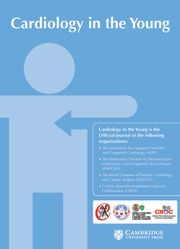Article contents
Association of race and ethnicity with resource utilisation among children with CHD: an evaluation of the National Health Interview Survey, 2010–2018
Published online by Cambridge University Press: 13 January 2023
Abstract
Racial and ethnic disparities in resource use among children with CHD remain understudied. We sought to evaluate associations between race, ethnicity, and resource utilisation in children with CHD.
Annual data from the National Health Interview Survey were collected for years 2010–2018. Children with self-reported CHD and Non-Hispanic White race, Non-Hispanic Black race, or Hispanic ethnicity were identified. Resource use in the preceding year was identified with four measures: primary place of care visited when sick, receiving well-child checkups, number of emergency department visits, and number of office visits. Cohort characteristics were compared across racial and ethnic groups using Kruskal–Wallis and Fisher’s exact tests. Multivariable logistic regression was used to determine the association of race and ethnicity with likelihood of having an emergency department visit.
We identified 209 children for the primary analysis. Non-Hispanic Black children had significantly more emergency department visits in the prior year, with 11.1% having ≥6 emergency department visits compared to 0.7% and 5.6% of Non-Hispanic White and Hispanic children. Further, 35.2% of Hispanic children primarily received care at clinics/health centres, compared to 17% of Non-Hispanic White children and 11.1% of Non-Hispanic Black children (p = 0.03). On multivariable analysis, Black race was associated with higher odds of emergency department visit compared to White race (odds ratio = 4.19, 95% confidence interval = 1.35 to 13.04, p = 0.01).
In a nationally comprehensive, contemporary cohort of children with CHD, there were some significant racial and ethnic disparities in resource utilisation. Further work is needed to consider the role of socio-economics and insurance status in perpetuating these disparities.
Information
- Type
- Brief Report
- Information
- Copyright
- © The Author(s), 2023. Published by Cambridge University Press
References
- 3
- Cited by


